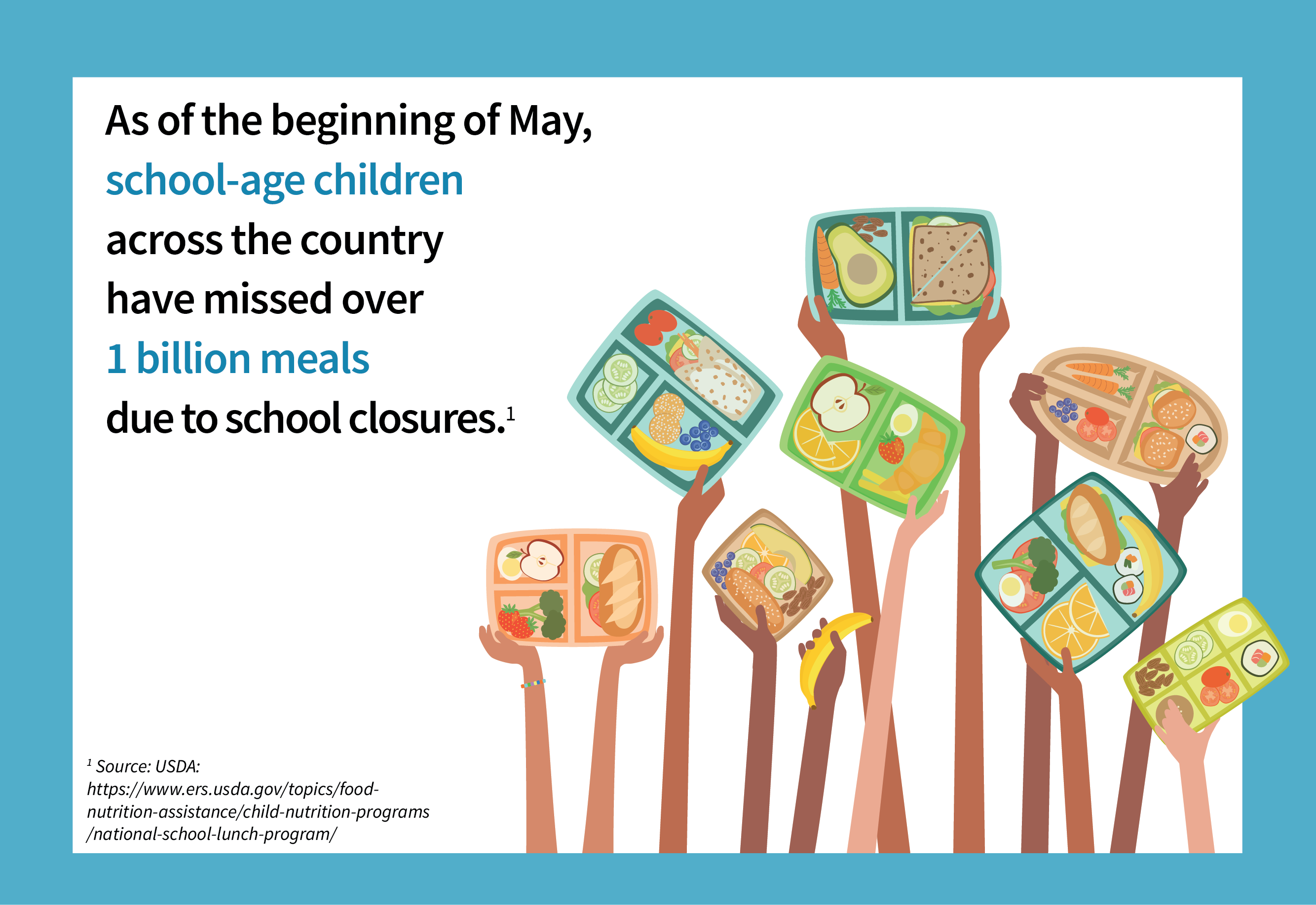
School cafeterias across the country have fallen idle over the past few months as schools have shuttered their doors to help limit the spread of COVID-19. On a typical day, schools provide low- or no-cost lunch to 29.7 million children.[1] As the COVID-19 pandemic stretches on and the unemployment rate continues to skyrocket, many families are finding it increasingly challenging to provide meals for their children. As of the beginning of May, school-age children across the country have missed over 1 billion meals due to school closures.[2] National food assistance programs, community food banks, and local school districts have quickly stepped in to help ensure kids have consistent access to nutritious meals during these uncertain times.
Below, we provide information about how families may secure food for their children, and how you can support organizations assisting families in need.
Ways to Get Help
1. Contact Your Local School District
Many school districts have set up policies and procedures to distribute food to families. In late March, the USDA announced nationwide waivers related to nutritional programs, including permitting states to allow parents to pick up food without their child present. In some districts, families arrive at designated meal pick-up sites and are provided with grab-and-go meal boxes or bags. In other districts, educators load meals onto school buses and meet families at spots along designated routes to drop-off meals – reducing the need for families to find transportation or rely on public transportation.
For example, the two largest school districts in the United States – New York City Public Schools and Los Angeles Unified School District – have created interactive platforms and maps (NYC DOE Free Meal Locator & LAUSD Grab-and-Go Food Centers) showing food distribution sites, so that families can locate the meal pick-up sites nearest them and receive more information about their operating hours and policies. Other smaller school districts also have such maps, including one created by Stanford University students showing distribution sites in California’s Bay Area. Districts without interactive maps typically list food distribution sites on their website and other social media platforms. If you are interested to know more, your local school district’s website should have information.
2. Review Information from Local & National Organizations that Support with Food Access
Local and national organizations are also working to make sure children have access to food during this time. Families in need of support can visit Foodassistance.us.gov to determine if they qualify for federal food assistance programs, including the Supplemental Nutrition Assistance Program (SNAP) and the Special Supplemental Nutrition Program for Women, Infants, and Children (WIC).
Many organizations are also engaged in efforts that extend beyond putting food into the hands of families. Although not an exhaustive list, the organizations below are advocating for federal assistance related to nutritional services, providing emergency funding and resources to community organizations, and actively disseminating information about where families can obtain free meals. You may find more information about reputable non-profits committed to providing COVID-19 relief and support by visiting
Charity Navigator.
- No Kid Hungry – Started in 2010 as a national campaign by Share Our Strength, No Kid Hungry is dedicated to promoting access to healthy, nutritional food for all kids. In response to the current crisis, they are liaising with the local and federal government to help pass legislation related to funding for food assistance, providing emergency grants to local community organizations, and ensuring that low-income communities receive the food and information about support services that they need. As part of this effort, No Kid Hungry developed an interactive map to help families find food assistance in their communities.
- Feeding America – As the nation’s largest hunger-relief organization, Feeding America oversees 200 foodbanks and 60,000 community food pantries and meal distribution programs across the country. They launched a COVID-19 response fund early on in the crisis, are working with government leaders to ensure robust federal nutrition programs, are partnering with school districts to supply food, and are providing emergency shipments to food banks across the country who desperately need additional supplies.
- Food Research and Action Center – As one of the leading non-profits addressing food security and undernutrition in the United States, FRAC conducts research, advocates for strong federal, state and local policies related to hunger, leads technical assistance work on nutrition and antipoverty initiatives, and engages in public information campaigns. As part of their COVID-19 response, FRAC published a Guide to Ensuring Children Have Access to Nutrition.
Ways to Give Help
According to a recent report by Feeding America, as a result of the Covid-19 pandemic, the number of food insecure children may rise from 11.2 million to 18 million.[3] As these numbers suggest, many families will require help obtaining food in the coming months. If you can, you may consider helping in the following ways:
- Making personal contributions to local and national organizations.
Depending on what works for you, consider monetary donations, donations of food, and/or volunteering your time (as allowed) to help these organizations continue operating at higher capacity. (NOTE: When donating to an organization, it’s a good idea to check Charity Navigator to see ratings about their financials and accountability/transparency ratings.)
- Be mindful of what you buy and when you buy.
Since not all products are SNAP or WIC eligible, those who can purchase non-SNAP and WIC designated items may want to consider this option, so that families who qualify for federal assistance can find the qualifying items on store shelves. This is especially true at the beginning of the month, when families receive WIC and SNAP benefits. Additionally, you may consider limiting the quantity of any item you purchase. While this is courteous to all customers, it especially helps families who cannot afford to purchase many items at one time.
Although these are challenging times, together we can help make sure that children have reliable access to healthy food.
Footnotes:
2 https://www.nokidhungry.org/coronavirus
3 https://www.feedingamerica.org/about-us/press-room/child-food-insecurity-could-hit-all-time-high
Topics: School-Community Partnerships
Tags: COVID-19
